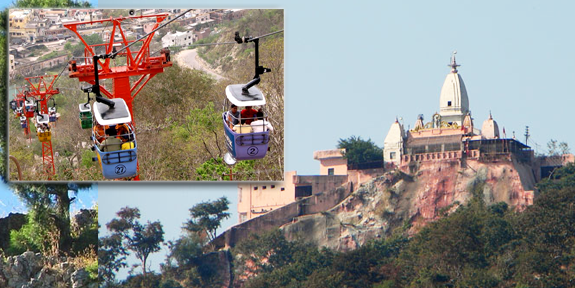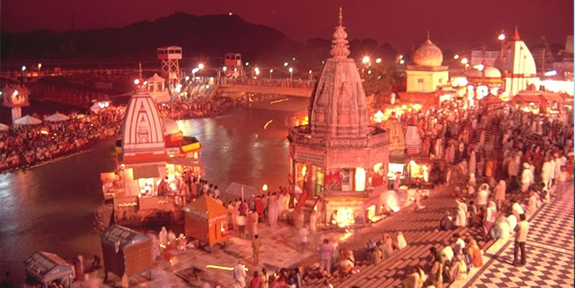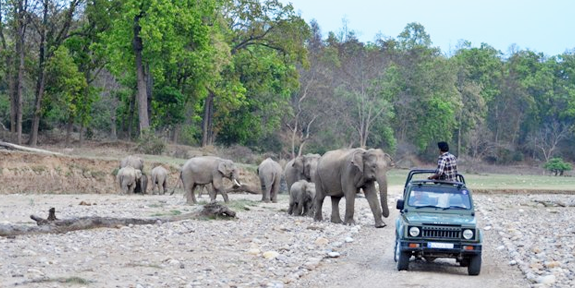Mansa Devi Temple

Mansa Devi Temple, Haridwar (Hindi: मंसा देवी मंदिर, हरिद्वार) is a Hindu temple dedicated to goddess Mansa Devi in the holy city of Haridwar in the Uttarakhand state of India. The temple is located atop the Bilwa Parvat on the Sivalik Hills, the southernmost mountain chain of the Himalayas. The temple also known as Bilwa Tirth is one of the Panch Tirth (Five Pilgrimages) within Haridwar.
The temple is known for being the holy abode of Manasa, a form of Shakti and is said to have emerged from the mind of the lord Shiva. Mansa is regarded as the sister of the Nāga (serpent) Vasuki. The term Mansa means wish and it is believed that the goddess fulfils all the wishes of a sincere devotee. Devotees who want their wishes to be fulfilled by Mansa tie threads to the branches of a tree located in the temple. Once their wishes are fulfilled, people come back again to the temple to untie the thread from the tree. Mansa is also offered coconuts, fruits, garlands and incense sticks in order to appease her.
Mansa Devi Temple is a Siddh Peetha which are the places of worship where desires get fulfilled. It is one of three such Peethas located in Haridwar, the other two being Chandi Devi Temple and Maya Devi Temple. The inner shrine has two deities installed, one with eight arms and the other one three headed with five arms
Har Ki Pauri

Jai Ganga Maa Har Ki Pauri (Hindi: हर की पौड़ी) is a famous ghat on the banks of the Ganges in Haridwar in Uttarakhand state in India. This revered place is the major landmark of the holy city of Haridwar. Literally, “Har” means “Lord Shiva” who is the god according to shaivite Rishav school of Hindu theology, “Ki” means “of” and “Pauri” means “steps”. Lord Shiva and Lord Vishnu are believed to have visited the Brahmakund in Har Ki Pauri in the Vedic times. There is a large footprint said to belong to Lord Vishnu on a stone wall.
It is believed that it is precise spot where the Ganges leaves the mountains and enters the plains. The ghat is on the west bank of Ganges canal through which the Ganges is diverted just to the north. Har Ki Pauri is also the area where thousands of pilgrims converge and the festivities commence during the Kumbha Mela, which takes place every twelve years, and the Ardh Kumbh Mela, which takes place every six years and the Punjabi festival of Vaisakhi, a harvest festival occurring every year in the month of April .
Chandi Devi Temple

Chandi Devi Temple, Haridwar (Hindi: चण्डी देवी मंदिर, हरिद्वार) is a Hindu temple dedicated to Goddess Chandi Devi in the holy city of Haridwar in the Uttarakhand state of India. The temple is situated atop the Neel Parvat on the Eastern summit of the Sivalik Hills, the southernmost mountain chain of the Himalayas. Chandi Devi Temple was built in 1929 by Suchat Singh in his reign as the King of Kashmir. However, the main murti of Chandi Devi at the temple is said to have been installed in the 8th century by Adi Shankaracharya, one of the greatest priests of Hindu religion. The temple also known as Neel Parvat Teerth is one of the Panch Tirth (Five Pilgrimages) located within Haridwar.
Chandi Devi Temple is highly revered by devotees as a Siddh Peetha which is a place of worship where desires get fulfilled. It is one of three such Peethas located in Haridwar, the other two being Mansa Devi Temple and Maya Devi Temple.
Rajaji National Park

Rajaji National Park is an Indian national park & Tiger Reserve that encompasses the Shivaliks, near the foothills of the Himalayas. It is spread over 820 km and three districts of Uttarakhand: Haridwar, Dehradun and Pauri Garhwal. In 1983, three wildlife sanctuaries in the area namely, Chilla, Motichur and Rajaji sanctuaries were merged into one.
Rajaji National Park has been named after C. Rajagopalachari (Rajaji), a prominent leader of the Freedom Struggle, the second and last Governor-General of independent India and one of the first recipients of India’s highest civilian award Bharat Ratna (in 1954).

